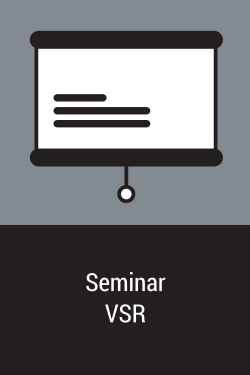
Pro-/Haupt- und Forschungsseminar VSR (SS 2024)
Welcome to the homepage of the Pro-/Haupt- und Forschungsseminar Web Engineering
This website contains all important information about the seminar, including links to available topics as well as information about the seminar process in general.
The interdisciplinary research area Web Engineering develops approaches for the methodological construction of Web-based applications and distributed systems as well as their continuous development (evolution). For instance, Web Engineering deals with the development of interoperable Web Services, the implementation of web portals using service-oriented architectures (SOA), fully accessible user interfaces or even exotic web-based applications that are voice controlled via the telephone or that are represented on TV and Radio.
The following steps are necessary to complete the seminar:
- Preparation of a presentation about the topic assigned to you.
- An additional written report of your topic.
- Each report is reviewed by other particpants.
Seminar chairs


Contact
If you have any questions concerning this seminar or the exam as a participant, please contact us via OPAL.
We also offer a Feedback system, where you can provide anonymous feedback for a partiular session to the presenter on what you liked or where we can improve.
Participants
The seminar is offered for students of the following programmes (for pre-requisites, please refer to your study regulations):
- Bachelor Angewandte Informatik (500110 Proseminar/500270 Hauptseminar)
- Bachelor Automobilinformatik (500110 Proseminar/500270 Hauptseminar)
- Bachelor Informatik (500110 Proseminar/500070 Hauptseminar)
- Bachelor Informatik und Kommunikationswissenschaften (500110 (2014) or 578310 (2021) Proseminar/500070 Hauptseminar)
- Master Angewandte Informatik (500090 Forschungsseminar)
- Master Automobilinformatik (500090 Forschungsseminar)
- Master Informatik (M_01 (2008) or 500090 (2021) Forschungsseminar)
- Master Automotive Software Engineering (500090 (2016) or 250000-013 (2022) Forschungsseminar)
- Master Neurorobotik (500090 Forschungsseminar)
- Master Informatik für Geistes- und Sozialwissenschaftler (500110 Proseminar (not anymore included in study documents from 2021), 500090 Forschungsseminar (2011, 2021))
Students who are interested in the Web Engineering Seminar (applies only to Master Web Engineering) will find all information here.
If your programme is not listed here, please contact us prior to seminar registration and indicate your study programme, the version (year) of your study regulations (Prüfungsordnungsversion) and the module number (Modulnummer) to allow us to check whether we can offer the seminar for you and find an appropriate mapping.
Registration
You may only participate after registration in the Seminar Course in OPAL
The registration opens on 21.03.2024 and ends on 07.04.2024 at 23:59. As the available slots are usually rather quickly booked, we recommend to complete your registration early after registration opens.
Topics and Advisors
Questions:
- What are GOMS/KLM Models? How do they work? Why are they used? What is the (data) basis on which they were created?
- For what kinds of user interfaces can they be or have they been applied? What are their limitations?
- Apply GOMS modeling to real world examples (e.g. vsr website) and demonstrate how they can be used to improve these interfaces.
Literature:
- https://cogulator.io/
- https://syntagm.co.uk/design/klmcalc.shtml
- https://www.cogtool.org/
- Card, S. K., Moran, T. P., & Newell, A. (1983). The psychology of human-computer interaction. Hillsdale, N.J. : L. Erlbaum Associates.
- Kieras, D. (1997). A guide to GOMS model usability evaluation using NGOMSL (Chapter 31). In M. Helander, T.K. Landauer & P.V. Prabhu (Eds.), Handbook of Human-Computer Interaction. Amsterdam: North-Holland Elsevier Science Publishers. Kim,
- John, B. and Kieras, D. The GOMS family of user interface analysis techniques: comparison and contrast. ACM TOCHI, 3 (4). 1996. 320-351.
- John, B. E. (2010). CogTool: Predictive human performance modeling by demonstration. 19th Annual Conference on Behavior Representation in Modeling and Simulation 2010, BRiMS 2010, 308–309.
Questions:
- What is signposting?
- How can signposting be applied to improve machine-readbility of resources on the Web?
Literature:
Questions:
- What are typical characteristics of HTTP versions?
- TCP, UDP, QUIC? What is used how below HTTP and how does it influence the protocol and its usage?
- A technical deep dive on demonstrators for HTTP version comparison with focus on HTTP/3 is expected.
Literature:
- own research
Questions:
- What are RDFSurfaces? Give a technical deep dive.
- How can RDFSurfaces help to improve decentralized knowledge graphs?
Questions:
- Create a corpus of Customer Service Chatbots that you analyze on certain criteria. The corpus should include at least 20 different chatbots (40 for Hauptseminar). For this you will get access to a gitlab repository in which you can save your results. Build a strategy on how to systematically search for these customer service chatbots and describe this methodology.
- The corpus should include at least information about the corporation, it's field, the source, how the chatbot introduces itself, if available information on the trained data, possible access restrictions, information on the user interface, etc.
- Additionally have a look at the code and categorize it. The following questions can be used as an idea for criteria and added on - use the available literature to formulate specific criteria: Is the code openly accessible and readable? Are third party chatbots used? If yes, which ones are used? Are the chatbots included via API-call etc. from the outside? How are they called on in the code?
Literature:
- own research
- Adamopoulou, E., Moussiades, L. (2020). An Overview of Chatbot Technology. In: Maglogiannis, I., Iliadis, L., Pimenidis, E. (eds) Artificial Intelligence Applications and Innovations. AIAI 2020. IFIP Advances in Information and Communication Technology, vol 584. Springer, Cham. https://doi.org/10.1007/978-3-030-49186-4_31
- Adamopoulou, Eleni, and Lefteris Moussiades. "Chatbots: History, technology, and applications." Machine Learning with Applications 2 (2020): 100006. https://doi.org/10.1016/j.mlwa.2020.100006
- Akma, N., Hafiz, M., Zainal, A., Fairuz, M., Adnan, Z.: Review of chatbots design techniques. Int. J. Comput. Appl. 181, 7–10 (2018). https://doi.org/10.5120/ijca2018917606
- M. Baez, F. Daniel, F. Casati and B. Benatallah, "Chatbot Integration in Few Patterns," in IEEE Internet Computing, vol. 25, no. 3, pp. 52-59, 1 May-June 2021, doi: 10.1109/MIC.2020.3024605.
Questions:
- Intro: As a data engineer and web-developer it is inevitable to understand the concepts of data privacy and licensing and its significance in today’s data- and software-driven world.
- Introduction and basic definitions: data, processing,
- Personal Data: definition, types of personal data, processing principles, anonymization and pseudo-anonymization, mixed data, documentation, data subjects’ rights
- Introduction and basic definitions: licenses
- Open Sources Licenses: definition, types of Open Source Licenses, overview of the most popular examples of Open Source Licenses with the respective conditions, compatibility of licenses (for instance in context of data fusion), review available websites and tools for Open Source License Management, including demonstrations
- Optional: - Discuss some legal challenges that arise for training data usage in connection with AI-models
- Optional: - Name and shortly explain current or planned legislation for AI applications
Literature:
Questions:
- How does Bun compare to its competitors? What does Bun do differently in terms of functionality?
- How does the architecture of Bun differ from Node.js and Deno?
- Compare the three runtimes - Deno, Bun and Node.js - by running different types of Benchmarks. Measure performance and memory consumption!
Literature:
- Own research
Questions:
- • Give a short introduction of the explainable AI (XAI) and Knowledge Graphs (KGs) and an short introduction of the role of KGs in XAI.
- • State and compare the respective opportunities and challenges of KGs in XAI.
- • Where is potential for an integration of both approaches and what would be the benefit of such synergies for various applications? (For ex. What is the benefits of using KGs in explainable recommendation systems)
- • Explain some ways KGs could be or already have been used to improve on XAI.
- • Give a more detailed review, supplemented by a short demonstration of one successful realization of one combined approach.
- • What are future trends in the XAI field?
Literature:
- 1. Lecue, F. (2020). On the role of knowledge graphs in explainable AI. Semantic Web, 11(1), 41-51.
- 2. Rajabi, E., & Etminani, K. (2022). Knowledge-graph-based explainable AI: A systematic review. Journal of Information Science, 01655515221112844.
- 3. Tiddi, I., & Schlobach, S. (2022). Knowledge graphs as tools for explainable machine learning: A survey. Artificial Intelligence, 302, 103627.
Questions:
- What are common methodologies for anti-spam?
- What are the recent years' changes on anti-spam?
- How does anti-spam tackle generative AI?
Literature:
- own research
Questions:
- What is the current State of the Art in constructing Knowledge Graphs from unstructured text?
- How can meaningful and appropriate entities be extracted with LLMs? Which Prompting Techniques help in improving the output of the model wrt. Entity Extraction?
- LLMs fall under the category of Generative AI. Hence, is it feasible and appropriate to employ LLMs to determine Entities that are not in the text, but can be logically derived from it?
- How do the approaches compare with standard NLP tools?
Literature:
- Own research
Seminar Opening
The date and time of the seminar opening meeting will be announced via OPAL.
Short Presentation
The date and time of the short presentations will be announced via OPAL.
In your short presentation, you will provide a brief overview on your selected topic.
This includes the following aspects:
- What is in your topic?
- Which literature sources did you research so far?
- What is your idea for a demonstration?
Following your short presentations, the advisors will provide you with feedback and hints for your full presentations.
Hints for your Presentation
- As a rule of thumb, you should plan 2 minutes per slide. A significantly higher number of slides per minute exceeds the perceptive capacity of your audience.
- Prior to your presentation, you should consider the following points: What is the main message of my presentaion? What should the listeners take away?
Your presentation should be created based on these considerations. - The following site provides many good hints: http://www.garrreynolds.com/preso-tips/
Seminar Days
The date and time of the seminar opening meeting will be announced via OPAL.
Report
- Important hints on citing:
- Any statement which does not originate from the author has to be provided with a reference to the original source.
- "When to Cite Sources" - a very good overview by the Princeton University
- Examples for correct citation can be found in the IEEE-citation reference
- Web resources are cited with author, title and date including URL and Request date. For example:
- [...] M. Nottingham and R. Sayre. (2005). The Atom Syndication Format - Request for Comments: 4287 [Online]. Available: http://www.ietf.org/rfc/rfc4287.txt (18.02.2008).
- [...] Microsoft. (2015). Microsoft Azure Homepage [Online]. Available: http://azure.microsoft.com/ (23.09.2015).
- A url should be a hyperlink, if it is technically possible. (clickable)
- Further important hints for the submission of your written report:
- Use apart from justifiable exceptions (for instance highlight of text using <strong>...</strong>) only HTML elements which occur in the template. The CSS file provides may not be changed.
- Before submitting your work, carefully check spelling and grammar, preferably with software support, for example with the spell checker of Microsoft Word.
- Make sure that your HTML5 source code has no errors. To check your HTML5 source code, use the online validator of W3.org
- For submission compress all necessary files (HTML, CSS, images) using a ZIP or TAR.GZ.
Review
- Each seminar participant has to review exactly three reports. The reviews are not anonymous.
- Following the review phase, each seminar participant will receive the three peer reviews of his or her report and, if necessary, additional comments by the advisors. You will then have one more week to improve your report according to the received feedback.
- The seminar grade will consider the final report.
All comments in the reviews are for improving the text and therefore in the interest of the author.


